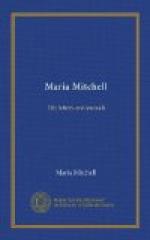London, 1873. “It was the 26th of August, and I had no hope that Miss Cobbe could be at her town residence, but I felt bound to deliver Mrs. Howe’s letter, and I wished to give her a Vassar pamphlet; so I took a cab and drove; it was at an enormous distance from my lodging—she told me it was six miles. I was as much surprised as delighted when the girl said she was at home, for the house had painters in it, the carpets were up, and everything looked uninhabitable. The girl came back, after taking my card, and asked me if I would go into the studio, and so took me through a pretty garden into a small building of two rooms, the outer one filled with pictures and books. I had never heard that Miss Cobbe was an artist, and so I looked around, and was afraid that I had got the wrong Miss Cobbe. But as I glanced at the table I saw the ’Contemporary Review,’ and I took up the first article and read it—by Herbert Spencer. I had become somewhat interested in a pretty severe criticism of the modes of reasoning of mathematical men, and had perceived that he said the problems of concrete sciences were harder than any of the physical sciences (which I admitted was all true), when a very white dog came bounding in upon me, and I dropped the book, knowing that the dog’s mistress must be coming,—and Miss Cobbe entered. She looked just as I expected, but even larger; but then her head is magnificent because so large. She was very cordial at once, and told me that Miss Davies had told her I was in London. She said the studio was that of her friend. I could not refrain from thanking her for her books, and telling her how much we valued them in America, and how much good I believed they had done. She colored a very little, and said, ’Nothing could be more gratifying to me.’
“I had heard that she was not a women’s rights woman, and she said, ’Who could have told you that? I am remarkably so. I write suffrage articles continually—I sign petitions.’
“I was delighted to find that she had been an intimate friend of Mrs. Somerville; had corresponded with her for years, and had a letter from her after she was ninety-two years of age, when she was reading Quaternions for amusement. She said that Mrs. Somerville would probably have called herself a Unitarian, but that really she was a Theist, and that it came out more in her later life. She said she was correcting proof of the Life by the daughters; that the Life was intensely interesting; that Mrs. Somerville mourned all her life that she had not had the advantages of education.
“I asked her how I could get a photograph of Mrs. Somerville, and she said they could not be bought. She told me, without any hint from me, that she would give Vassar College a plaster cast of the bust of Mrs. Somerville. [Footnote: This bust always stood in Miss Mitchell’s parlor at the observatory.] She said, as women grew older, if they lived independent lives, they were pretty sure to be ‘women’s rights women.’ She said the clergy—the broadest, who were in harmony with her—were very courteous, and that since she had grown old (she’s about forty-five) all men were more tolerant of her and forgot the difference of sex.




